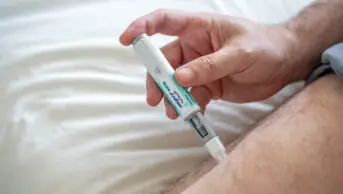
Alfred Pasieka / Science Photo Library
Self-administered insulin is the mainstay of treatment for type 1 diabetes. However, most insulin-dependent patients suffer from complications due to poor adherence or inadequate glycaemic control.
To overcome these issues, US researchers synthesised an insulin derivative that is activated by a molecular switch that responds to blood glucose. When administered in a diabetic mouse model, the modified insulin responded to a glucose challenge more rapidly than either standard insulin or a long-acting insulin formulation (insulin detemir).
The responsiveness of the modified insulin was similar to that of a healthy pancreas and some derivatives were able to respond to repeated glucose challenges over a 13-hour period. The new insulin represents a step “toward the generation of more autonomous therapy with improved blood glucose control”, the researchers conclude in PNAS (online, 9 February 2015)[1]
.

Smart, glucose-responsive insulin
Source: Matthew Webber
When blood sugar is high, the insulin derivative, called Ins-PBA-F, becomes active. One injection can repeatedly normalise blood sugar levels over a minimum of 14 hours in mice with a type 1 diabetes-like condition


